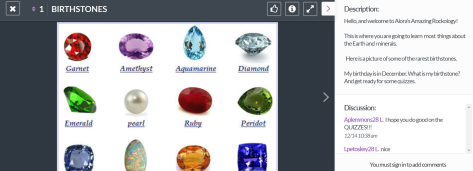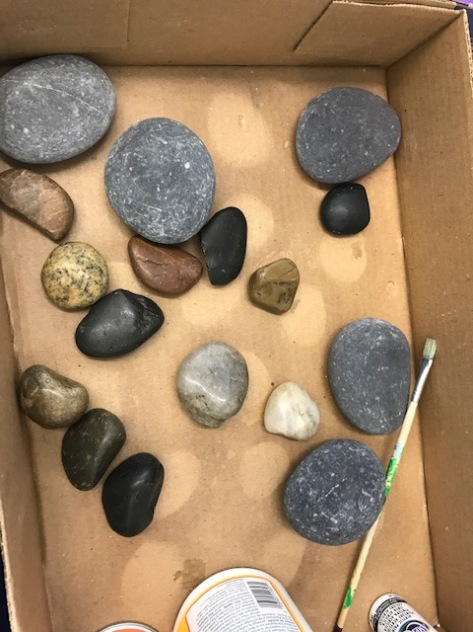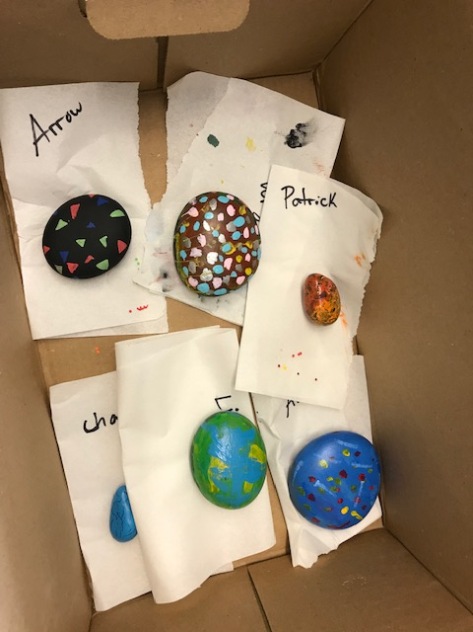
Our 3rd graders study rocks every year as a part of their science curriculum. This year, we brainstormed some new ideas to support this study and scheduled two 45-minute sessions for each 3rd grade class.

Session one focused on facts and observations. To begin, I asked student to put themselves in the shoes of a researcher and consider what someone researching rocks might do. They named things such as reading books, talking to experts, doing experiments with rocks, going outside and looking for rocks, and visiting websites and videos. For this session, students rotated between 3 stations. Each station lasted for approximately 10 minutes. I didn’t want them to be slowed down by writing down facts, so this day was just an exploration to mentally gather as many facts as they could. Some students still chose to write things down but most took my advice of making mental notes.
Center 1: Books

I gathered multiple books from our nature section of library. Prior to this center, I reminded students how they might dive in to multiple books without reading entire books. We reviewed the table of contents, index, and captions. As students explored this station, the teachers and I noticed students talking about photographs that caught their attention so we jumped in to the conversation by directing students to text or captions that supported the conversation. So often, I see students chat about photographs and forget to read the text, so we tried to gently intervene to make sure the conversation was based in fact rather than speculation. One of the biggest hits at this stations was learning about birthstones and making a personal connection to gemstones.


Center 2: Rocks

When I was growing up, my grandmother and grandfather took me to Cherokee, North Carolina to visit ruby and gem mines. My grandmother would save her money all year and then buy multiple bags of dirt containing gems and we would spend hours sifting through the dirt in a water trough. I saved the rocks from all of those trips and now they have become a part of my educator collection.
At this station, students used this mix of rocks to make observations and sort rocks in different ways. I included to large circles that students could use as a Venn diagram and compare and contrast rocks based on texture, size, shine, and more. All students worked together to sort as many rocks as time allowed.

Center 3: Websites and Videos

Amethyst is February’s birthstone and also Georgia’s state gem. This station focused on exploring amethyst through websites and videos using a Symbaloo. One of our favorite sites is Gem Kids because it allows students to see gems under a microscope, on a map of the world, and see photos of gems with captions full of info. Students also loved watching the Jackson’s Crossroads video from Georgia to see what amethyst looks like when it is found.

Day 2 of our exploration focused on creativity. We read the book A Rock Can Be… by Laura Purdie Salas and Violeta Dabija. At the conclusion of this poetic book, it says “go a discover what else a rock can be”. This invitation brought us to our next explorations. This time rather than rotating every 10 minutes, students rotated as they finished each step.
Center 1: Artistic Creations

Students once again found boxes of rocks that they could observe. However, this time, their goal was to use the rocks to create something new. They could create a word, shape, object, or anything their creativity sparked. Once they made this creation, they used an iPad to snap a photograph.
This center was fun to watch because every student had a different way of making something. Some had an object in mind already like a football, and they used the rocks to make that shape. Others found one rock that inspired them and they used that rock to form what came to their mind. This was also the station where we saw so many students shine. I loved that whether a student had an English barrier, a reading challenge, etc, this was a visual station that allowed so many voices to be heard in a strong way.
Center 2: Poetry

As students finished photography, they moved to writing in another part of the library. If students had a poem already forming in their mind, they could use a blank piece of paper to create it. However, if students needed some extra support, they used A Rock Can Be… as a mentor text. I had a simple organizer with a structure already formed for them with “a rock can be” and some blanks to create two-word lines in their poem.

The teachers and I did a lot of conferencing at this station to help students focus on the photograph that they created. Most students had their photograph pulled up on their iPad as they wrote. Some chose to focus more on rocks in their poem while others focused on whatever shape they had created.
Center 3: Recording

Students moved to quiet space in the library to put all of their creativity together in Flipgrid. I setup our grid to have a guest code so that students could scan a QR code, enter their first/last name, and start recording. They could record their face on the video or flip the camera and record their poem. During the final step, students imported the photograph of their creation and then used the Flipgrid stickers to add another layer of artistic expression. This final step was tricky because it was tempting to add lots of the fun stickers. However, I encouraged the students to think about what stickers added to their photograph and brought their rock to life. I loved seeing what some of the students chose from the sticker assortment.
Going into these 2 days, I was really unsure of how it would all connect together, but once I saw the flow, I really like what happened. I especially enjoyed day 2 and the creativity that came from our students. I need to do a bit more thinking about day 1. I think it was a great mix of modalities, but I do wonder about what I could do to keep the students more focused in the centers, especially the reading center. It might be as simple as drawing out a card that says “pick a word from the index to read more about” or “flip to a random page and read a caption”.
All in all, I’m excited about the creations we made. I invite you to visit our Flipgrid and view and like the student poetry videos.


































